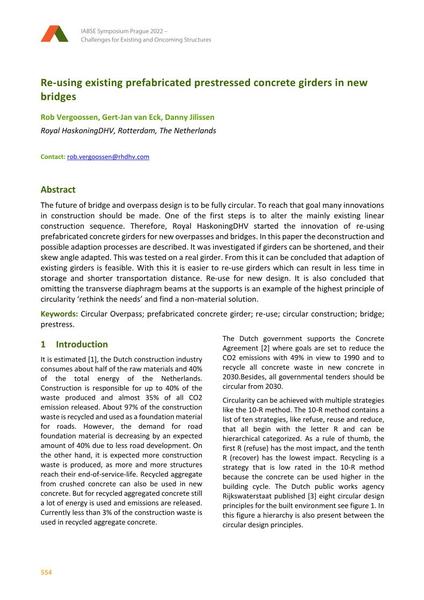Re-using existing prefabricated prestressed concrete girders in new bridges

|
|
|||||||||||
Détails bibliographiques
| Auteur(s): |
Rob Vergoossen
(Royal HaskoningDHV, Rotterdam, The Netherlands)
Gert-Jan van Eck (Royal HaskoningDHV, Rotterdam, The Netherlands) Danny Jilissen (Royal HaskoningDHV, Rotterdam, The Netherlands) |
||||
|---|---|---|---|---|---|
| Médium: | papier de conférence | ||||
| Langue(s): | anglais | ||||
| Conférence: | IABSE Symposium: Challenges for Existing and Oncoming Structures, Prague, Czech Republic, 25-27 May 2022 | ||||
| Publié dans: | IABSE Symposium Prague 2022 | ||||
|
|||||
| Page(s): | 554-561 | ||||
| Nombre total de pages (du PDF): | 8 | ||||
| DOI: | 10.2749/prague.2022.0554 | ||||
| Abstrait: |
The future of bridge and overpass design is to be fully circular. To reach that goal many innovations in construction should be made. One of the first steps is to alter the mainly existing linear construction sequence. Therefore, Royal HaskoningDHV started the innovation of re-using prefabricated concrete girders for new overpasses and bridges. In this paper the deconstruction and possible adaption processes are described. It was investigated if girders can be shortened, and their skew angle adapted. This was tested on a real girder. From this it can be concluded that adaption of existing girders is feasible. With this it is easier to re-use girders which can result in less time in storage and shorter transportation distance. Re-use for new design. It is also concluded that omitting the transverse diaphragm beams at the supports is an example of the highest principle of circularity ‘rethink the needs’ and find a non-material solution. |
||||
| Mots-clé: |
pont
|
||||
| Copyright: | © 2022 International Association for Bridge and Structural Engineering (IABSE) | ||||
| License: | Cette oeuvre ne peut être utilisée sans la permission de l'auteur ou détenteur des droits. |
||||
